5 Ways to Practice Yoga for Better Sleep

Let’s get a little personal for a moment: how have you been sleeping lately? If your answer is something like “not great,” you’re in no way alone. Lack of adequate sleep is arguably an unspoken epidemic amongst Western culture adults, leading to fuzzier cognition and memory, more negative affect (“moodiness”), and even dire long-term health impacts such as the greater risk for heart attacks. Could yoga for better sleep be a sustainable, and even enjoyable, solution?
Seeking better sleep, people have tried everything from scheduling hacks to medicinal sleep aids to technologies like calming soundscapes. If these have worked for certain individuals, wonderful. They’ve gotten the relief that they need. Absent that, gentle yoga poses for sleep can help calm the mind, ease the body, and even regulate body temperature. These are all things that individuals can do to help their systems naturally downshift into a deep sleep state.
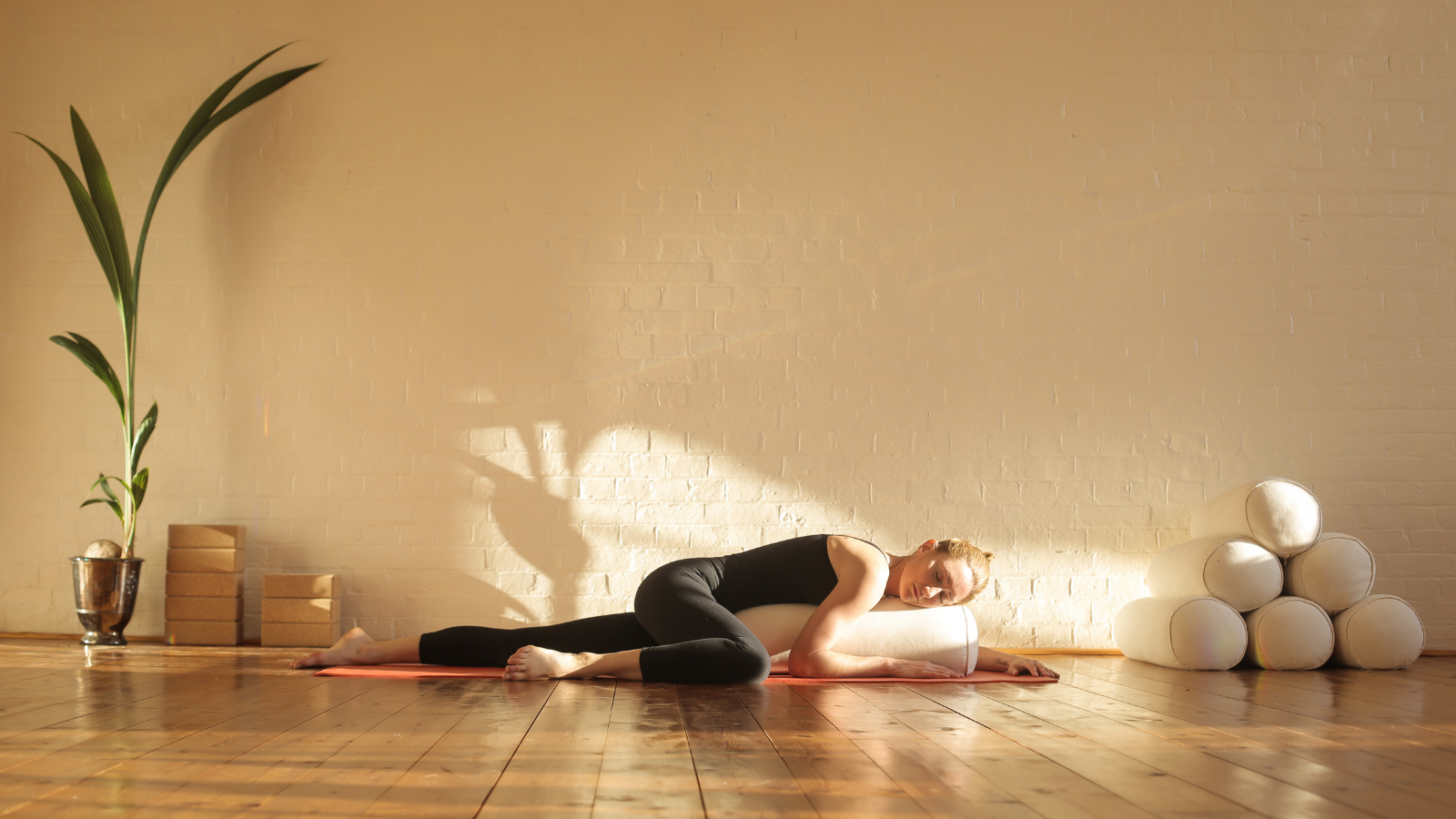
How to Practice Yoga for Better Sleep
Let’s look at this short yoga sequence for insomnia or other sleep issues. You’ll need a few blankets and/or pillows and a clear wall. An ideal surface to practice on is a yoga mat, carpet, or another soft surface.
To start, here are a few basic tips to be aware of as you practice yoga for better sleep:
Tip #1: Breathing out for longer than you breathe in (for example, inhaling for three counts and exhaling for six counts) can help cool and relax the body and mind. You can practice that throughout the following practice, or at any point during it, to the extent that’s accessible and sustainable to you.
Tip #2: When the noise and commotion of the day die away, and it’s time for sleep, it’s natural for our brains to turn over thought afterthought. Our thoughts run from unpacking the day behind you, wondering about the day ahead or even beyond that. This can make it hard to shift into sleep. Throughout this practice, as thoughts arise, try to pay them no mind. As you may have heard before, let them float by like clouds in the sky. The less attention we give those thoughts, the less centrality they often have in our consciousness.
Tip #3: Hold the following poses (or practice the following breathwork) for the recommended number of breaths, or do so longer if you have the time and that feels nurturing to you. If your body is telling you to come out sooner, of course, do. You are your best teacher.
Cooling Breath for Better Sleep: Sitali Breath
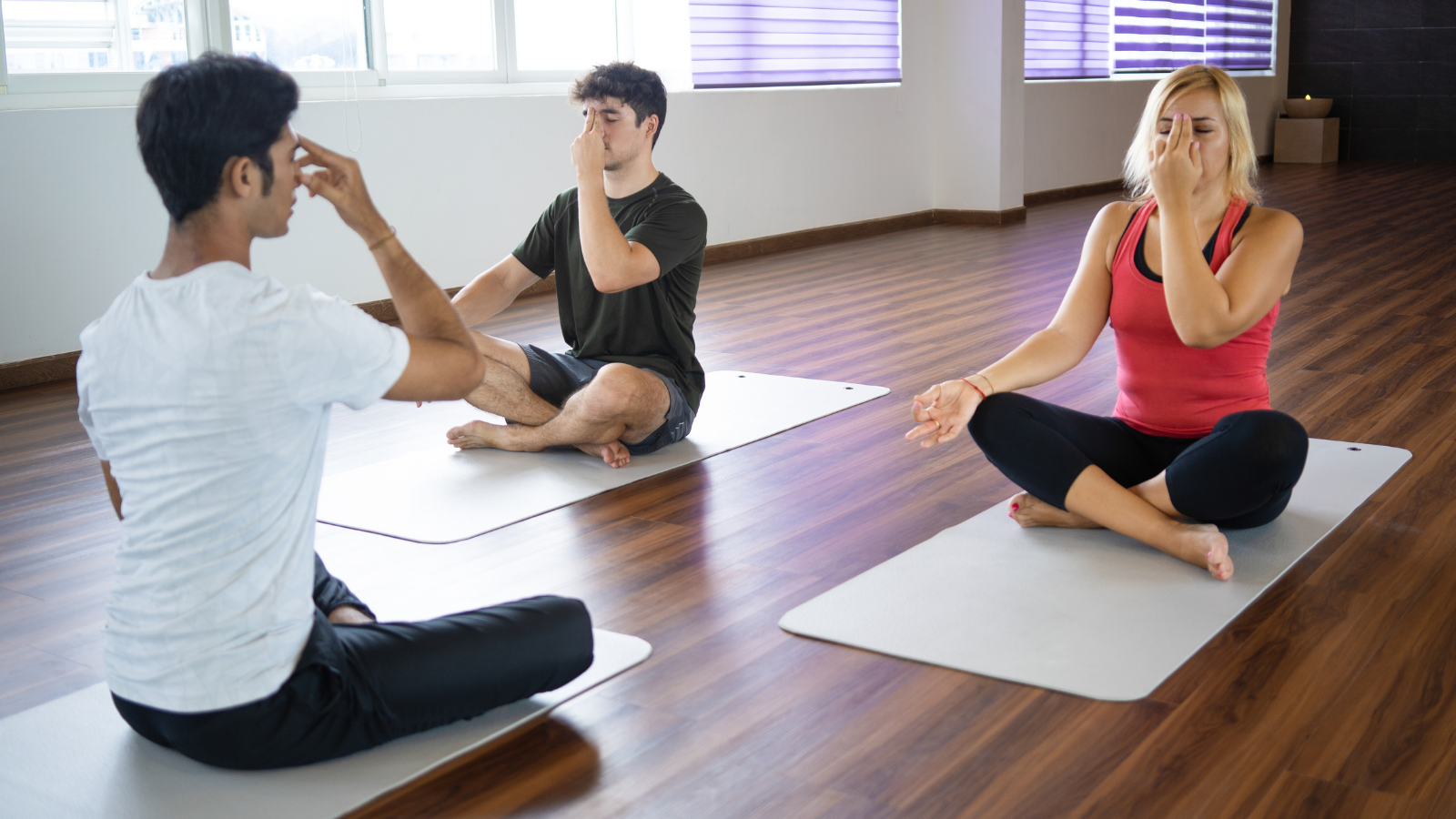
The body cools down for sleep, and a cooler body can contribute to falling asleep more easily (as well as sleeping more restfully). This breathing technique can help cool down the body.
- Sit in Easy Pose (Sukhasana) on a pillow, meditation cushion, or a (neatly) folded blanket.
- Root down through your seat. At the same time, feel a gentle rising through your spine, like a flower stable in its roots but rising to the sun. This will allow for fuller and more nurturing breath.
- Take a few natural breaths. Notice any notable messages from your body.
- Curl your tongue into a taco shape (the sides rising up toward the roof of your mouth). Breathe in through your curled tongue.
- Release your tongue taco, letting your tongue lay flat again. Breathe out through your nose.
- Repeat that 3 to 5 times.
- Breathe naturally and check in with how you feel.
If you can’t curl your tongue (not everyone can), instead touch the top of your tongue to the roof of your mouth as you breathe in. Or try Sitkari Breath, touching your teeth together and opening your lips wide on your inhalation.
Surrender to Rest: Seated Forward Bend Pose (Paschimottanasana)
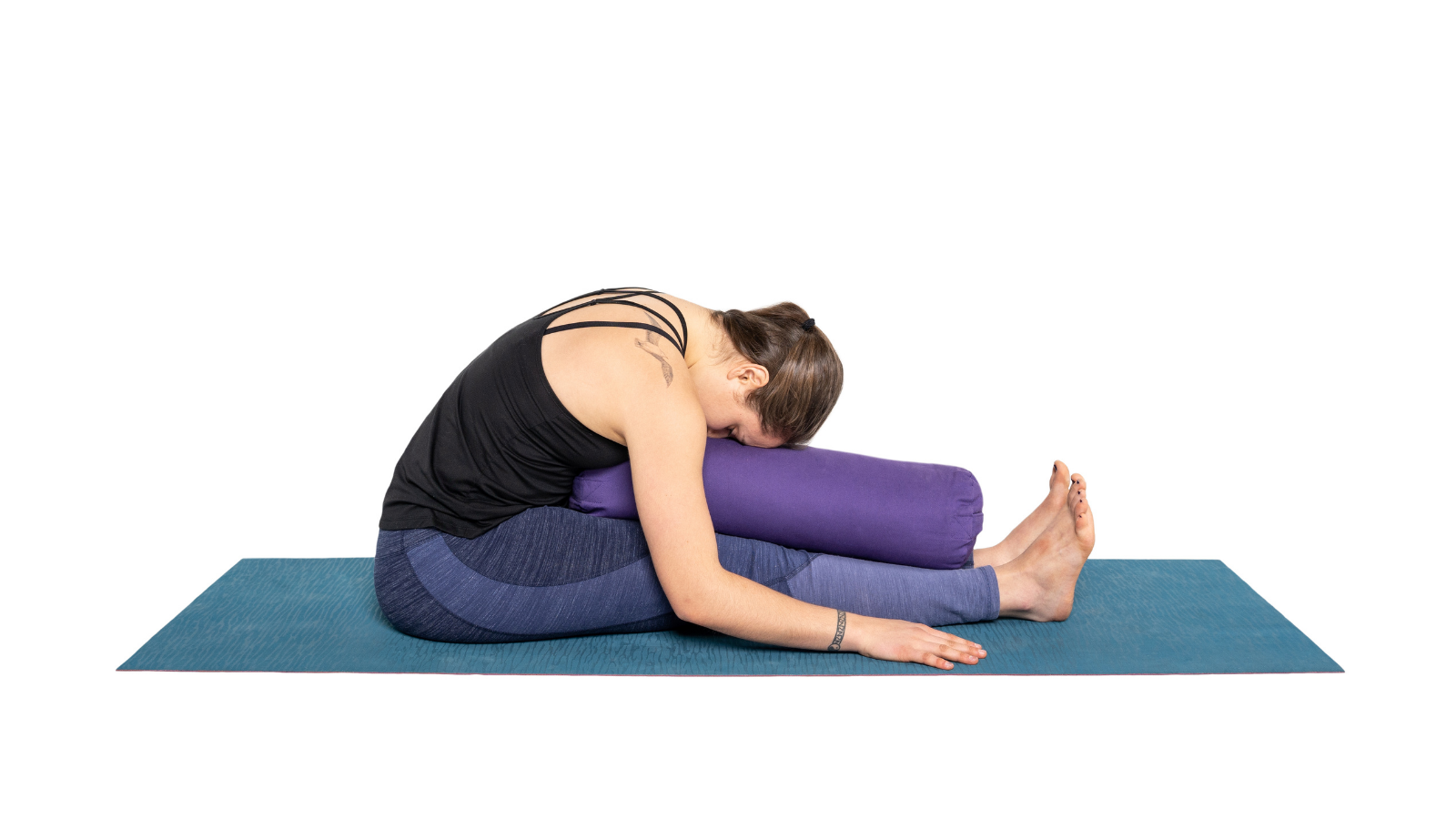
Folding forward naturally “downshifts” the nervous system, which is essential for falling and staying asleep. It’s a sort of surrender, in this case, a surrender to rest.
- Remain seated on your pillow or folded blanket, but straighten your knees and stretch your legs out in front of you in Staff Pose (Dandasana).
- Direct your toes and knees to face up to the sky, gradually and easefully. Try to avoid “muscling” anything, as we’re looking to help the body relax here.
- Place another blanket or pillow just above the backs of your knees (on your very lower thighs). This will cause your knees to gently bend. Allow for that.
- Place an additional pillow or blanket on your thighs.
- Place your hands on your hips and tilt your tailbone backward. Allow that to initiate a gentle, gradual fold forward from your hips.
- Keep folding forward until your head comes to the pillow resting on your thighs. Allow your head to rest there, and adjust the placement of the pillow, if necessary. You might even want to place another pillow on top of the first one. If it feels hard to breathe face-down on the pillow, turn your head to one side and rest on one cheek instead.
- Let your hands rest by your sides, palms facing down. Or if it feels good to you, you can make another pillow for your head with your hands by placing one on top of the other under your forehead.
- Stay here in this pose for 10 to 15 easy breaths.
- When the pose is complete for you, slowly and mindfully raise your torso back to vertical. For a few easy breaths, check in with how your yoga poses to wind down feel for you.
Grounding Yoga for Better Sleep: Reclining Bound Angle Pose (Supta Baddha Konasana)
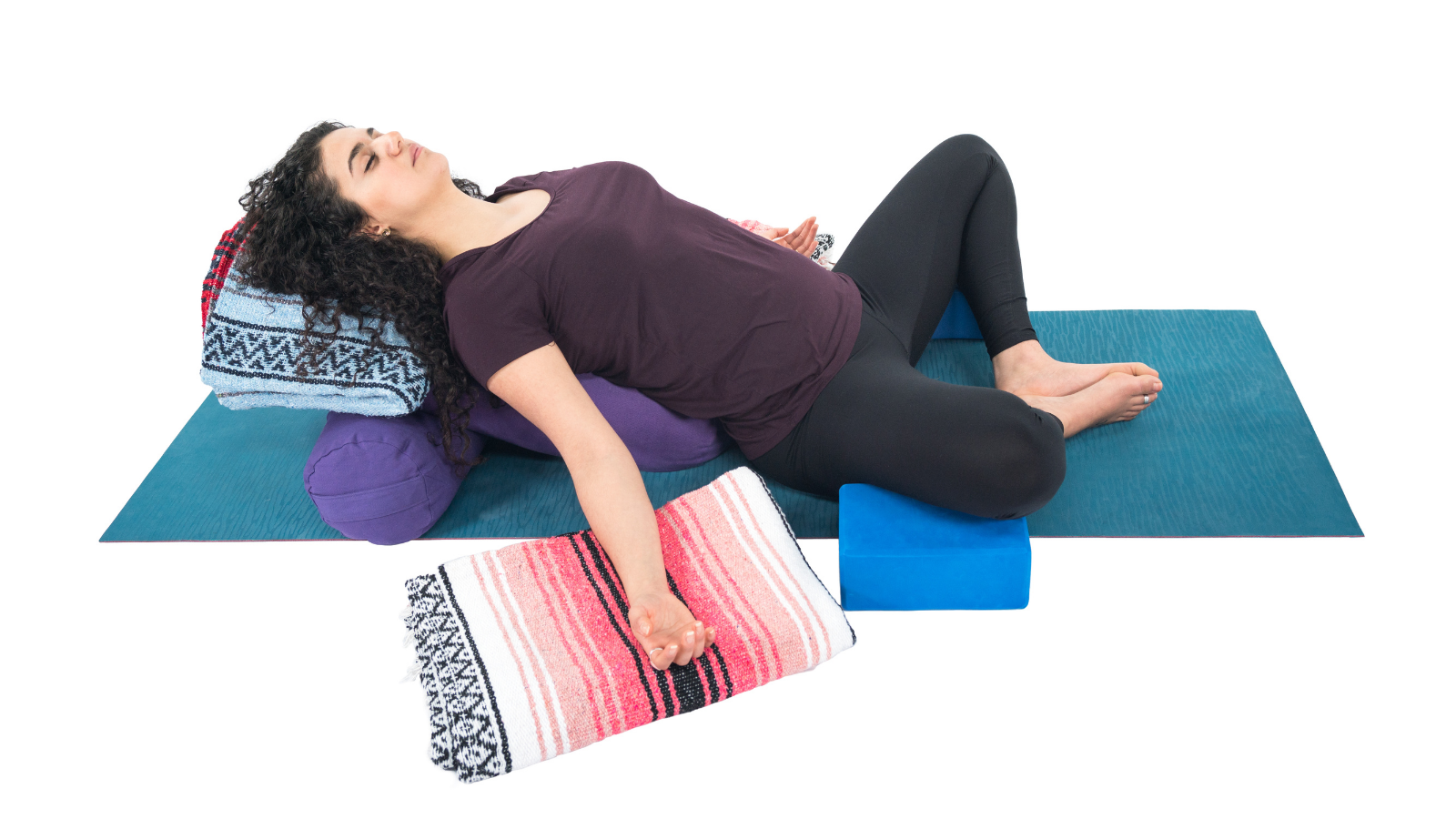
Supine poses are another way to “downshift” the nervous system in preparation for restful sleep.
- If you’re working with blankets, fold two of your blankets in half. (They’re likely already folded in half from the prior pose, so in reality, they’re folded in quarters). If you’re working with pillows, just make sure they’re within reaching distance.
- Place one blanket or pillow so that it will be underneath your head when you lie on your back. Make your best guess—you can always adjust it later if you miss the mark.
- Bend your knees and place the bottoms of your feet together, so that your legs form a diamond shape. Then place one prop under each knee (either folded blankets or pillows).
- Your props set, lie unto your back. Adjust the placement of your head support if needed.
- Drape your hands by your sides, palms facing down. You could also place your palms on your belly if that feels nice to you.
- Check in with your body and make any other adjustments so that you feel fully restful here. For example, you can adjust the distance between your feet and pelvis, drawing your heels farther away or closer, moving your props along with them.
- Once you’ve created a pose that feels truly restful to you and supportive of you, soften and rest here for 10 to 15 breaths.
- When the pose feels complete, press into your hands and gradually raise your torso back to vertical. Remove the props under your knees and gently lengthen your legs.
- It might feel good to swish your legs from side to side, taking soft movement. Move in any other way that might feel nurturing to you, but nothing too energetic. Remember that we’re trying to cool and relax the body in preparation for sleep.
- Take a few easy breaths and notice how your yoga poses for better sleep feel.
Releasing What You Don’t Need: Legs Up the Wall (Viparita Karani)

Among many other benefits, inversions can reverse the flow of bodily fluids. As a gentle inversion, Viparita Karani can initiate that effect, helping the body more easily achieve restful sleep. And it’s also just plain relaxing!
- Head to your clear wall, moving slowly and easefully.
- Place one blanket or pillow, the long edge parallel to the wall, a few inches away from the wall.
- Sit on the prop, with your feet and legs parallel to the wall. Then twist your torso to face toward the wall.
- Shift your body so that your legs lengthen up the wall and you’re lying on your back, with your pelvis slightly elevated by resting on the prop.
- As with the prior pose, drape your hands by your side, palms facing down or rest them on your belly if that feels nice to you.
- Make any adjustments that you may need to feel fully supported and restful here.
- Remain in the pose for 10 to 15 easy breaths. If you begin to feel tingling sensations in your feet and legs, even if you haven’t completed the above number of breaths, it’s time to come out of the pose.
- To come out of the pose, shift your legs back to the starting position—your feet and legs parallel with the wall and your prop.
- Gently press into your hands so that you rise to a seated position. Take a few easy breaths to notice how you feel.
Imagining Calm: A Visualization for Falling Asleep
Those wandering and wondering thoughts aren’t an inevitability. Straightforward meditation exercises can calm the mind and body, allowing them to drop into sleep.
Return to your Easy Pose (Sukhasana) or any other comfortable position. Wherever you settle, find spaciousness and ease through your body, particularly in your torso so that your breath can stay smooth and deep.
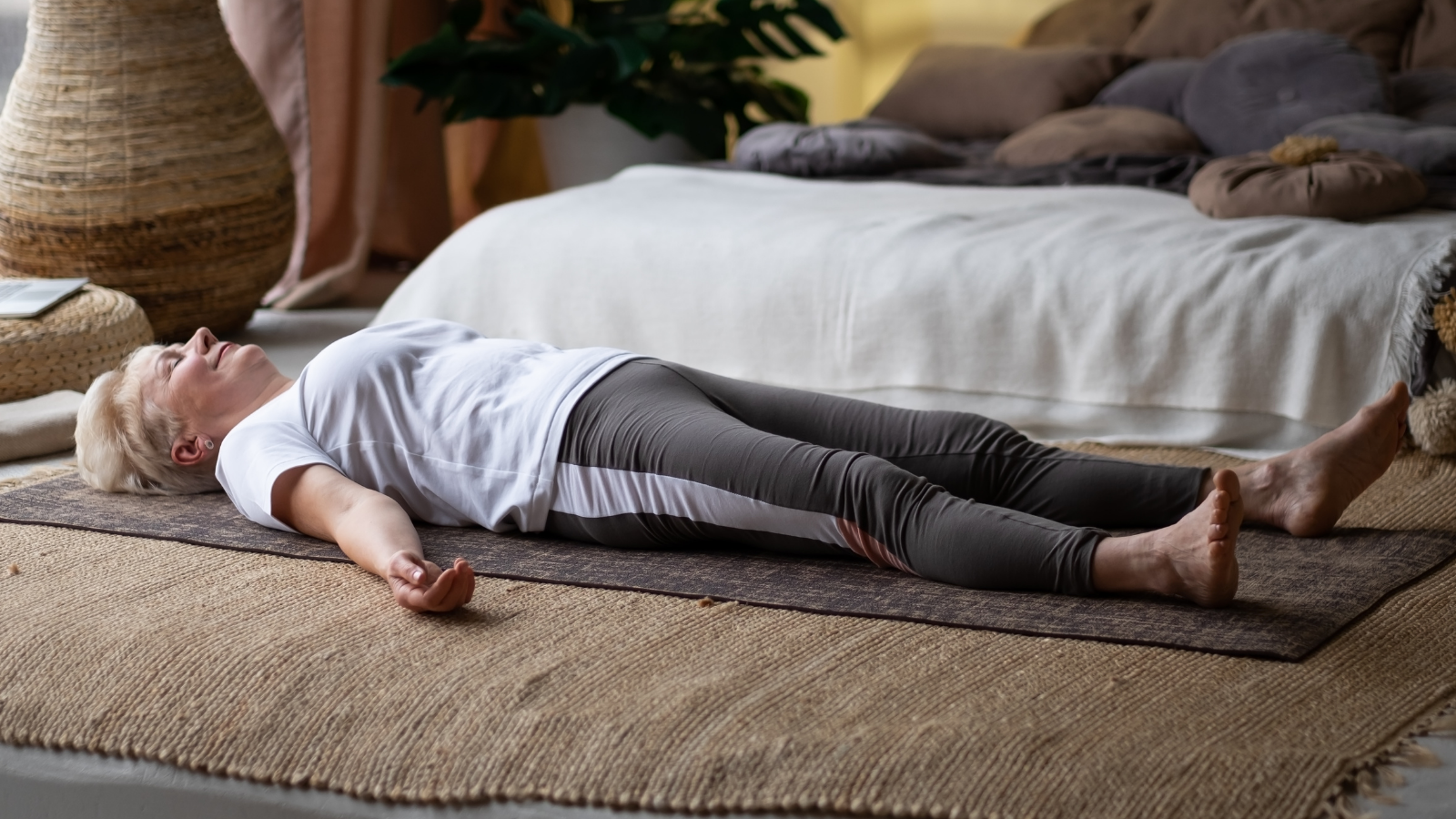
Visualize a stream of temperate, clear water beginning to gently flow from the top of your head toward your toes. It flows from your head and neck, down through your torso, out your arms, legs, and pelvis, and finally out your toes. As it passes over each body part, it washes away, from each and every cell, anything that you no longer need as you settle into sleep—thoughts about your day or tomorrow, physical tension, anxiousness, excitability.
Once the stream hits your toes, let it keep washing over your whole body for a few more breaths, taking away the last of what you don’t need to drift into a deep, restful sleep.
Let the visualization gradually fade away. Notice how you feel.
If you’re ready to get into bed, go right ahead. Otherwise, handle any last steps (brushing your teeth, going to the bathroom, et cetera) before you’re ready to do so. Enjoy falling into a truly nourishing sleep, your gentle nighttime yoga has helped you get there.
Also, read...
15 Natural Remedies For A Good Night’s Sleep
Exploring the Link Between Sleep and Anxiety
Yogic Breathing for Better Sleep – Balancing Apana and Prana Vayus
Related courses

Kathryn Boland is an RCYT and R-DMT (Registered Dance/Movement Therapist). She is originally from Rhode Island, attended The George Washington University (Washington, DC) for an undergraduate degree in Dance (where she first encountered yoga), and Lesley University for an MA in Clinical Mental Health Counseling, Expressive Therapies: Dance/Movement Therapy. She has taught yoga to diverse populations in varied locations. As a dancer, she has always loved to keep moving and flowing in practicing more active Vinyasa-style forms. Her interests have recently evolved to include Yin and therapeutic yoga, and aligning those forms with Laban Movement Analysis to serve the needs of various groups (such as Alzheimer’s Disease patients, children diagnosed with ADHD, PTSD-afflicted veterans – all of which are demographically expanding). She believes in finding the opportunity within every adversity, and doing all that she can to help others live with a bit more breath and flow!
- https://pubmed.ncbi.nlm.nih.gov/32357858/
- https://pubmed.ncbi.nlm.nih.gov/26478577/
- https://www.sciencedirect.com/science/article/abs/pii/S1744388119305377
- https://www.sciencedirect.com/science/article/abs/pii/S1087079215001604




